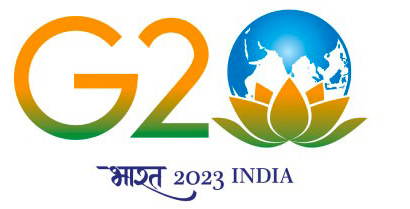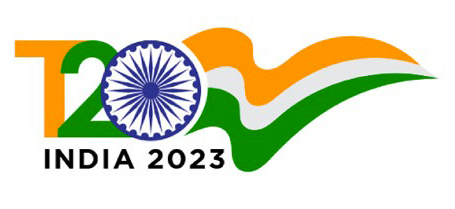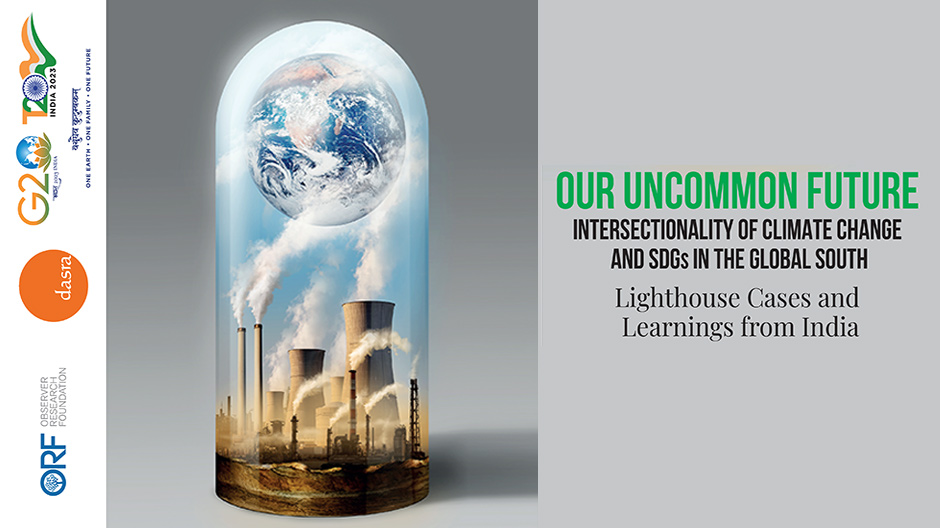Attribution: Nilanjan Ghosh and Aparna Roy, Eds., Our Uncommon Future: Intersectionality of Climate Change and SDGs in the Global South – Lighthouse Cases and Learnings from India, July 2023, Observer Research Foundation.
Climate Change and the SDGs: Understanding Intersectionality and Causality
Nilanjan Ghosh
As the mid-term review of the SDGs approaches in September 2023, it will not be an exaggeration to state that the global development paradigm is at a critical crossroad. The COVID-19 pandemic exposed the vulnerabilities of economies, globally, irrespective of their positions in the development curve, and just when post-pandemic economic revival seemed to be in the offing, the Ukraine-Russia war emerged as another exogenous shock to the global economy, thereby further derailing the development goals.
With this global backdrop, India assumed the G20 presidency in December 2022. Many observers claim that India is the mid-point of the G20 troika of the Global South, with Indonesia being its predecessor and Brazil the successor in taking up the presidency. However, India’s position, more aptly, should be taken as the second corner of the quadrilateral of the Global South as South Africa is slated to take over the G20 presidency after Brazil. While the G20, under various presidential dispensations, has always taken up the SDGs as one of its key verticals, this Global South quadrilateral presidency will be in a position to represent the concerns of developing countries even more vociferously.
However, there is a perennial stressor for the global development ambitions: global warming and climate change. No doubt, the SDGs, which are the cornerstone of global development governance, have been impeded by this “global common bad” (as opposed to the good[a]). The G20 under the Indian presidency adequately appreciates this, as seen in various communiqués.[1], [2]
In 2015 the era of the millennium development goals ended, and the development agenda found a more comprehensive form in the 2030 Agenda for Sustainable Development involving the global call for adoption of the 17 Sustainable Development Goals (SDGs) that speak of reconciling sustainable living, distributive justice, and economic progress (Figure 1). This brings about a critical dimension in the global paradigm of development governance that can more aptly be described as the reconciliation between the “irreconcilable trinity” of equity, efficiency, and sustainability. This trinity delineates what development economist Mohan Munasinghe calls the “discourse of Sustainomics”[3] (Figure 2).
Figure 1: The UN Sustainable Development Goals

Source: https://www.un.org/sustainabledevelopment/blog/2015/12/sustainable-development-goals-kick-off-with-start-of-new-year/#
The 17 SDGs are not always in consonance with each other, and in many cases, can indeed be conflictual. It can often happen that the ecosystem-based SDGs, through the ways they have been attempted to be achieved traditionally, can go against the equity-based SDGs. For example, conservation efforts by governments in more traditional set-ups have resulted in uprooting human habitat from and around protected areas, thereby adding to the miseries of the poor who are dependent on the ecosystem services. The challenge of development governance therefore requires a reconciliation between these goals. In the course of this reconciliation, the SDGs highlight the importance of co-existence of human societies and natural ecosystems: after all, the former is dependent on these ecosystems for the goods and services they provide free of cost. In other words, destruction and degradation of biodiversity brings about insurmountable losses in the capacity of the natural ecosystem to provide fundamental services to human communities, thereby raising questions on the long-term sustainability of lives and livelihoods. Therefore, in the SDGs, one finds the co-existence of various equity goals (e.g., ending poverty and deprivations, reducing inequality, improving human capital), efficiency parameters (e.g., economic growth and industrialisation) and goals on conservation of the natural ecosystem that are sustainability oriented. Finally, global partnership to realise the remaining 16 goals is espoused under SDG17.
Compounding the challenge is that all the SDGs need to be achieved while combating forces of global warming. SDG13 therefore talks of climate action to combat climate change either through mitigation and/or adaptation. Climate change has ubiquitous impacts on all human endeavours, thereby affecting SDG achievements.
This present volume deals with the intersectionality of SDGs with climate change, and in all cases hindering their achievements. It takes up the Indian case in the year of its G20 presidency and highlights all these intersectionalities in the Indian context. The statement for India definitely fits into the narrative posed by the stylised facts as obtained from various global experiences, and yet—as this volume highlights—there are Indian nuances that have yet to be explicitly addressed in the literature. This is the gap that this volume attempts to bridge.
Figure 1: The ‘Sustainomics’ Triangle
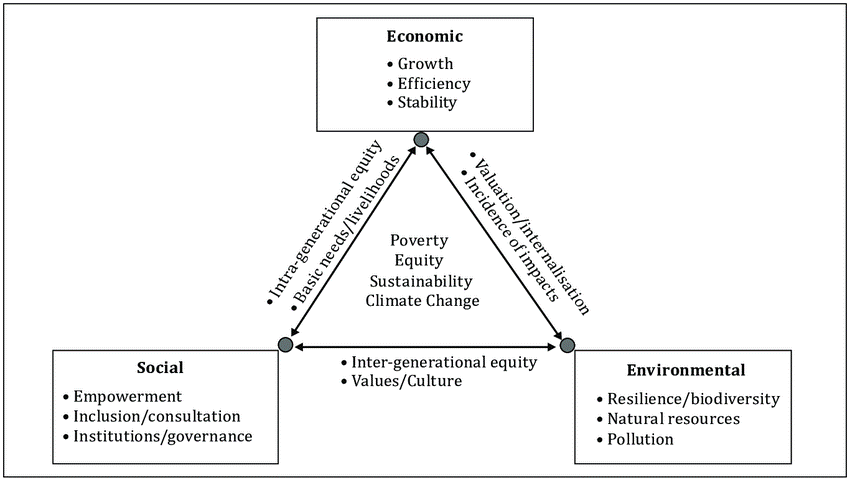
Source: Ghosh (2017)[4]
Climate Change and SDGs: The Bidirectional Causality
The intersectionality of climate change and SDGs is complex and multifaceted. Though ‘intersectionality’ emerged as a popular concept from the discipline of critical race theory, it has found its application in other domains including gender studies, environmental studies, and sustainability. Intersectionality acknowledges that different aspects of a person’s identity—such as race, gender, sexuality, and class—interact with each other, creating unique experiences of oppression and privilege. In the context of climate change and sustainable development, intersectionality recognises that environmental problems and solutions are not isolated from other social and economic issues but are instead interconnected and interdependent. The intersectionality problem posed here therefore takes up the bidirectional causality between climate change and the various SDGs, and therefore highlights the importance of achieving SDG13 in achieving the other SDGs. While climate change is a significant obstacle to achieving the SDGs, progress on the SDGs can help mitigate and adapt to climate change. Understanding the intersectionality of climate change and SDGs is critical for developing effective solutions to both challenges.
- Climate change affects the achievement of the SDGs. It impacts all aspects of sustainable development, including poverty reduction, health, education, gender equality, and economic growth. For example, climate change can exacerbate food insecurity and malnutrition by reducing agricultural productivity and increasing the frequency and severity of droughts, floods, and other extreme weather events. Climate change can also contribute to the spread of diseases such as malaria and dengue fever, which disproportionately affect the poorest and most vulnerable populations. Thus, climate change hinders the achievement of SDGs, especially in the developing and the underdeveloped world, which are most vulnerable to its impacts.
- SDGs can help mitigate and adapt to climate change. The SDGs offer a promising framework for addressing climate change. Many of the SDGs have specific targets related to climate change mitigation and adaptation. For example, SDG13 (Climate Action) aims to strengthen resilience and adaptive capacity to climate-related hazards and natural disasters. SDG7 (Affordable and Clean Energy) promotes the use of renewable energy sources, which can help reduce greenhouse gas emissions. SDG11 (Sustainable Cities and Communities) aims to make cities and human settlements inclusive, safe, resilient, and sustainable, which can help reduce vulnerability to climate change impacts. Thus, the SDGs provide a roadmap for addressing climate change and achieving sustainable development.
How Climate Change Affects the SDGs
This intersectionality and the bidirectional causality bring to forth the importance of an integrated and holistic approach to sustainable development. To begin with, climate change is not merely an environmental problem: it is a developmental problem rooted in unbridled human ambitions towards promoting economic development often looked at only through the lens of GDP growth. Such a paradigm creates externalities like emission of CO2 or equivalent in the atmosphere—the final impacts of which are felt in human lives, livelihoods and various development parameters as delineated by the SDGs. At the same time, the poorer nations with lower levels of educational attainment and economic prosperity are the ones who have little resilience or shock-absorption capacities to climate change.
Indeed, climate change disproportionately affects the world’s poorest communities who are often more reliant on natural resources for their livelihoods and have less capacity to adapt to changing conditions. Often, climate change can alter the ecosystem structure thereby influencing ecosystem functions, and eventually, diminishing the ecosystem services on which the poor are highly reliant. Given how a large portion of the poor’s livelihoods emerge from the ecosystem services, these are often called the ‘GDP of the poor’.[5] This comes in the way of achieving SDG1 (No Poverty). Again, in the context of SDG2 (Zero Hunger), climate change can lead to reduced crop yields and increased food insecurity, particularly in regions that are already vulnerable to food insecurity.
In the context of SDG3, climate change can have significant impacts on human health, including increased risks of vector-borne diseases, heat stress, and malnutrition. Climate change can disrupt educational systems thereby affecting achievement of SDG4, particularly in regions that are vulnerable to extreme weather events or changes in environmental conditions. This has spillover effects to SDG5, as women and girls are often more vulnerable to the impacts of climate change, particularly in regions where they have limited access to resources and decision-making power. Again, climate change can lead to changes in water availability and quality, which can impact human health and well-being, thereby affecting attainment of SDG6 (Clean Water and Sanitation). However, attainment of SDG7 (affordable and clean energy) helps in climate mitigation efforts by reducing greenhouse gas emissions through transition to clean energy sources, which can support economic development and reduce energy poverty.
At the same time, climate change can have significant impacts on economic stability by reducing human productivity, disrupting supply chains, and causing changes in natural resource availability that are often the most fundamental factors of production. In the process, they affect work conditions and business environment, and hinder economic growth. Therefore, climate change is inimical to SDG8 (decent work and economic growth). Meanwhile, Industry, SDG9 (Innovation and Infrastructure) that aims to “build resilient infrastructure, promote inclusive and sustainable industrialisation and foster innovation”, will require energy that will also lead to carbon emissions—this goes against SDG13. Therefore, the cross-cutting nature of SDG9 and SDG13 originate from the former being inimical to the latter, while again addressing climate change requires innovation and investment in sustainable infrastructure and technology.
However, climate change is a massive social stressor and can aggravate existing inequalities, worsening poverty. This is also because the poor are more vulnerable to climate change, being bereft of the means of resilience. Therefore, SDG10 (reduced inequality) gets negatively affected in the process. In fact, as far as SDG11 is concerned, cities need to develop adaptive mechanisms as well as mitigative measures to combat the forces of climate change being exposed to risks of flooding, pollution and heat. Reducing greenhouse gas emissions requires changes in consumption and production patterns, including reducing waste and promoting sustainable practices. This creates the inextricable linkage of climate action and SDG12.
There is also ample scientific evidence of SDG14[6] and SDG15[7] (life on earth and under water) being affected by climate change. At the same time, the ocean ecosystem also serves as a crucial carbon sink, thereby helping carbon action. On a similar note, climate change acts as a stressor and impedes achievement of SDG16 of achieving Peace, Justice and Inclusion as important ends in and of themselves. Viewed more deeply, SDG16 is a critical enabler for achieving other SDGs, like ending poverty, ensuring education or conserving oceans. In a world of feud and conflict that is also often exclusionary, it is not possible to achieve the SDGs. Climate change can lead to natural resource conflicts due to scarcity and depletion, and may even lead to exclusion of vulnerable communities.[8] However, SDG17 (global partnerships) is needed urgently, as collective action at the global level is imperative for achieving SDG13.
Climate Action: Adaptation is Crucial for Global South
In many parts of the developing and the underdeveloped world, post-pandemic economic recovery has hinged on promoting economic growth through large-scale capital expenditures on physical infrastructure. India is no exception. Though this may be construed as a continuation of the trend that prevailed even before the pandemic, it is now being taken up with an even greater emphasis in large parts of the Global South encompassing South Asia, the BRICS (Brazil–Russia–India–China–South Africa) region, and Africa.[9],[10] This entails large-scale land-use change from green cover that are carbon sinks and an annual source of carbon sequestration to creating linear infrastructure to meet the needs of growing urbanisation.
The challenge is that large parts of the world view climate action only through the lens of energy transition from fossil fuels to renewable energy sources. Yet, it cannot be overemphasised that energy transition alone is not the panacea to all the problems faced by humankind. Land-use change from forests, grasslands, and coastal ecosystems to physical infrastructure creates losses in the carbon sink and annual carbon sequestration processes.[11] This also results in the release of the historically stored carbon and depletion of some of the critical ecosystem services—such as regulation of carbon sequestration. Mere energy transition cannot substitute for such losses, and unbridled land-use change can counteract the positive impacts that would otherwise have accrued from the energy transition.
At the same time, mitigation efforts are not sufficient at all. The Global South needs adaptation as wherewithal for mitigation might not be available, and at the same time, mitigation may not resolve the entire problem faced by these nations. As an example, in the Indian Sundarbans Delta (ISD) in the state of West Bengal in India, the landmass is shrinking due to sea-level rise and simultaneous decline in sediment flows due to upstream construction over the mainstream Ganges. Ingression of saline waters have made agriculture unviable. Further even, embankments are not turning out to be sustainable solutions due to regular breaching in times of extreme events like cyclones and storm surges. Locally, large tracts of agricultural lands are being converted to fisheries and shrimp culture as an organic adaptation process by the communities.[12] Further, it is feared that certain vulnerable regions might cease to exist by 2040[13] under business-as-usual climate scenario. Suggestions are being made for the “strategic retreat” of populations from the vulnerable regions to more stable regions—such newer modes of adaptation measures become extremely important here.[14]
Despite the importance of adaptation in the Global South, climate financing has been lopsided and biased towards mitigation efforts. This was pointed out by a Joint Report on Multilateral Development Banks’ Climate Finance published in 2018 and prepared by the European Bank for Reconstruction and Development, together with the African Development Bank, the Asian Development Bank, the European Investment Bank, the Inter-American Development Bank Group, the Islamic Development Bank and the World Bank Group.[15] According to World Bank economist Govinda Timilsina,[16] the apparent bias towards mitigation occurs due to two reasons. First, results from mitigation investment are perceptible in the short run, e.g., returns on investments in energy efficiency or in renewable energy can be perceived through the financial cost savings, as well as from the estimable break-even periods.
The same is not true for adaptation projects. For instance, returns on investment in cyclone-resistant structures might not be perceptible if cyclones do not occur. Further still, it is difficult to find funders for adaptation modes such as the “strategic retreat” of populations to safer zones, since returns on such investments have long gestation periods and their impacts on lives and livelihoods are often difficult to predict. Second, adaptation projects find less traction amongst funding agencies because of the ‘public goods’ nature of such projects. Large parts of the public-sector climate finance for climate-change mitigation leverages private-sector finance, and the private sector does not consider financing ‘public goods’ as viable investments. In comparison, the private-sector financing of clean-energy technology is increasing, given their clear linkage with investments and returns.
Even the Green Climate Fund (GCF) initially had a bias towards funding mitigation projects, as opposed to those for adaptation. As of 16 March 2023, 60 percent of nominal funding has gone into mitigation projects, while 40 percent has gone into adaptation funding.[17] This is simply not sufficient. In March 2023, participants in a meeting hosted by Agence Française de Développement and ORF reiterated the overall bias against adaptation projects in terms of initiatives and funding. It seems as if adaptation has largely been a community-driven, organic initiative which often receives little attention from governments and multilaterals. One reason that came out from the meeting for this indifference of policymakers towards adaptation is the varying definitions of “projects” between the MDBs (multilateral development banks) and the CSOs.[18] This often results in many adaptation projects not being considered as worthwhile initiatives to receive funding.
This present volume concerns itself more with the adaptation element of climate action. In the process, the chapters adopt the Drivers-Pressures-State-Impacts-Response (DPSIR) framework to analyse the various initiatives while talking about the intersectionalities, and how climate action largely in the form of adaptation can help combat the impacts of climate change.
The Drivers-Pressures-State-Impacts-Response (DPSIR) Framework[b]
The DPSIR framework helps in understanding the bidirectional causality between societies and natural ecosystems. Initially developed by the OECD,[19] the framework was further modified by the EEA[20] and the UNEP[21] in order to relate human activities to the state of the environment.
Drivers: The drivers are the societal, demographic, and economic movements as well as the accompanying transformations in production methods, ways of life, and overall consumption levels. These drivers originate externally to the environmental system and involve influences or unexpected events arising from the social, economic, and institutional systems. They generate pressures on the environmental condition, either directly or indirectly. These driving forces frequently interact and do not follow a hierarchical structure, influencing the structure and dynamics of the social, economic, political, and environmental systems.[22] The drivers are classified into four categories: primary, secondary, tertiary, and base drivers. The primary driving forces arise from human economic activities such as industry, agriculture, and tourism. The secondary driving forces encompass policies (e.g., forest or wetlands policy, statutes) or policy changes. The tertiary driving forces emerge in the long term and have a broader spatial impact, driven by shifts in perceptions and lifestyle (e.g., media influences, evolving consumption patterns). Lastly, the base driving forces consist of fundamental trends (demographic or cultural) that are shaped by long-term social decisions.
Fig. 1: The Generic DPSIR framework
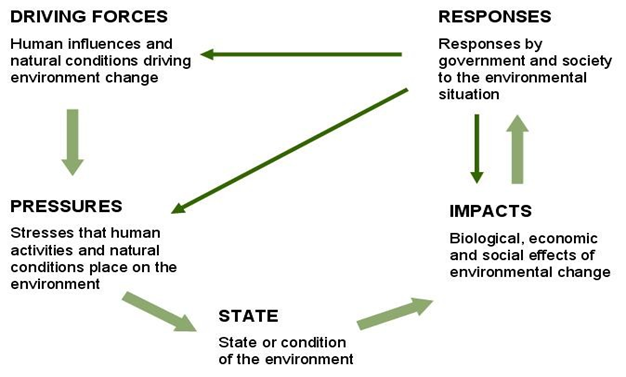
Source: Bandyopadhyay et al[23]
State: The existing condition of a system, whether natural or socio-economic or the interface of the two, delineates the State. This entails both qualitative and the quantitative facets of the social or the natural ecosystem, human society, quality of life indicators to even larger socio-economic issues.
Impacts: Drivers exert pressures on the existing State. These pressures make their presence felt through Impacts that entail changes in a social-ecological space. The changes may be observed in the local or regional economy, or the natural ecosystem and concomitant ecosystem functions and services, thereby affecting environmental, social and economic dimensions. These might be in the form of water and air quality, soil fertility, and health or social cohesion.[25] Essentially, Impacts entail the resulting influences on human well-being through various channels that may be human-induced or natural.
Response: Impacts trigger responses either in the form of an organic mode from within a community or through a policy action. Either way, the Responses are actions driven towards mitigation or adaptation processes to combat the impacts either through elimination or reduction of their negative consequences or promotion of positive consequences. Social groups, individuals, governments, civil society groups can come up with the responses. Essentially, it is a feedback loop of impacts that help initiate responses. In turn, responses can influence trends in the drivers, which in turn, can alter or modify the entire loop.
It would be useful to go back to the case of the Indian Sundarbans Delta discussed earlier in this chapter. The key driver in this case is resuscitation of the Kolkata port that was getting sedimented, for which the Farakka barrage was constructed in the mainstream Ganges. The pressure point emerges from the streamflow depletion and sediment deposition in the upstream of the Farakka and also from sea-level rise. While sea-level rise has been historically leading to subsidence of land, the land resuscitation from the sediment flow through the creeks and canals are not sufficient due to decline in sediment flow. This leads to the state, i.e., the delta ecosystem to shrink on one hand, and on the other, salinity ingression has led to salination of the soil thereby making the agricultural lands unsuitable for paddy cultivation.
What is the community level response mechanism? This has been in the form of adaptation through conversion of agricultural land to brackish water fishery. What is the policy level response mechanism? This is through construction of embankments that are also getting breached in the process. Here, the response mechanism is more from an adaptation perspective rather than mitigation. One also will note the adoption of solar energy in the Indian Sundarbans region, where fossil fuel-based electricity could not penetrate at scale. How does the feedback loop work here? The feedback loop therefore shows that the responses can neither address the drivers, nor the pressure points. Rather it only addresses the state, thereby implying that a different model of adaptation needs to be utilised.
About this Volume
This volume delves into the intersectionality of climate action with a few selected SDGs—namely, SDG2, SDG3, SDG5, SDG11, SDG12, SDG15, and SDG17. Although the authors and editors chose these SDGs for this volume, the other goals are equally important. There are two overarching rationales for focusing on these SDGs. First, these SDGs are proverbial low-hanging fruits in terms of understanding their multiple points of intersectionalities with the forces of climate change at both conceptual and human perceptive levels. Second, given the cross-cutting nature and the inextricable linkages of these SDGs with others that have not been considered in these articles, the analyses can lead to separate and more informed evaluations of the intersectionalities between climate change and the other SDGs. Certain indications can be made out from this volume.
There are seven chapters in this compendium that seek to address the intersectionalities. DPSIR is adopted as a cross-cutting framework for analysing the various cases and for documenting best practices from across the world. With its focus largely on adaptation and building resilience, the volume takes up Indian cases and identifies appropriate mechanisms that can inform policymakers as they intervene in this domain. Chapter 2, authored by Promit Mookherjee, takes up SDG15 (Life on Earth)—the goal that is fundamental to the existence of largely terrestrial and non-oceanic life forms on the planet, and assesses how climate change interacts and intersects with this goal. In Chapter 3, Gopalika Arora and Aparna Roy outline the challenges posed by climate change to the urbanscape or the ecosystem of cities. Anirban Sarma, in Chapter 4, then weaves the story of the intersectionality between climate change and health, and highlights some of the responses from India, being an important representative of countries in the Global South. Shoba Suri writes about climate-resilient food systems in Chapter 5, highlighting the dynamic interactions between climate change and food production and thereby addressing SDG2’s intersectionality with the forces of climate change. Chapter 6 by Swati Prabhu takes on an interesting challenge: it looks at how global climate change intersects with SDG17 while considering the gender equality dimension as propounded by SDG5. The last essay, Chapter 7, by Akshay Shetty and Kirti Jain evaluates the multi-stakeholder approach to climate action and highlights the roles of civil society organisations (CSOs).
The volume further seeks to highlight innovative interventions and solutions that address the issues posed by these intersectionalities, especially for India’s most vulnerable and marginalised communities. These cases not only provide insights, best practices and lessons shared by diverse actors on driving equitable climate action and strengthening community resilience, but they also offer replicable frameworks for application in the Global South with comparable settings. Therefore, in that sense, the Indian cases presented here can serve as ‘lighthouse’ cases and applications that show plausible pathways for many other nations grappling with similar problems.
Despite climate change being posed as a global common, its impacts are differentiated and it is untenable to pose the hypothesis of a “common future” for the planet. Together, these articles take up the case for a differentiated future, keeping in mind the concerns of the Global South; they make the case for an “uncommon” future. At the same time, this volume attempts, in the year of India’s G20 presidency, to create a platform for showcasing, on one hand, the Indian leadership in the domain of climate action, and on the other, learnings for India from best practices in other parts of the globe.
Read the entire report here.
Endnotes
[a] A “good” is defined as a commodity or a service that provides benefits to human communities. As opposed to that, a “bad” is defined as that commodity or service that is harmful.
[b] Large portions of this section take inspiration from: Jayanta Bandyopadhyay, Nilanjan Ghosh and Chandan Mahanta, IRBM for Brahmaputra Sub-basin: Water Governance, Environmental Security, and Human Well-Being (New Delhi: Observer Research Foundation, 2016.)
[1] G20 India, “First Meeting of the G20 Development Working Group,” G20 India Press Release, December 12, 2022.
[2] Shilpa S., “India’s G20 Presidency – A shorter path to fulfil SDGs amidst the climate change,” The Hindustan Times, January 10, 2023.
[3] Mohan Munasinghe, Sustainable Development in Practice: Sustainomics Methodology and Applications (Cambridge University Press, 2009).
[4] Nilanjan Ghosh, “Ecological Economics: Sustainability, Markets, and Global Change,” in Global Change, Ecosystems, Sustainability: Theory, Methods, Practice, ed. Pranab Mukhopadhyay et al. (New Delhi: Sage, 2017).
[5] Pavan Sukhdev, “Costing the earth,” Nature 462 (2009):277.
[6] Yadvinder Malhi et al., “Climate change and ecosystems: threats, opportunities and solutions,” Philosophical Transactions of the Royal Society B 375 (2020).
[7] Zoi Vrontisi et al., “Macroeconomic impacts of climate change on the Blue Economy sectors of southern European islands,” Climatic Change 170 (2022):1-21.
[8] Nilanjan Ghosh, “Governing the Himalayan Rivers in South Asia: A Review of the Challenges in the Ganges and the Brahmaputra through the Lens of Paradigmatic Changes” in Security, Development and Sustainability in Asia Vol. 3., ed. Zhiqun Zhu (Singapore: World Scientific Publishing Company, 2023).
[9] Laurance William et al., “Road Expansion and the Fate of Africa’s Tropical Forests”, Frontiers in Ecology and Evolution (2017).
[10] Nilanjan Ghosh, “The Fate of the Green Agenda: Does Multilateralism Have a Future?”, The Valdai Club, April 26, 2022.
[11] Karina Winkler et al., “Global Land Use Changes are Four Times Greater than Previously Estimated,” Nature Communications 12, 2501 (2021).
[12] Nilanjan Ghosh, “Climate Change and Agrarian Systems: Adaptation in climatically vulnerable regions”, Indian Journal of Agricultural Economics 73, no. 1 (2018): 38-53.
[13] Anamitra Anurag Danda et al., “Managed Retreat: Adaptation to Climate Change in the Sundarbans ecoregion in the Bengal Delta,” Journal of Indian Ocean Region (2019):317-335.
[14] Nilanjan Ghosh et al., “Away from the Devil and the Deep Blue Sea: Planned Retreat and Ecosystem Restoration as adaptation to Climate Change,” Policy Research and Innovation Group, Issue Brief No. 1 (New Delhi: WWF India, 2016).
[15] European Bank for Reconstruction and Development, Joint Report on Multilateral Development Banks’ Climate Finance, 2018.
[16] Govinda R. Timilsina, “Financing Climate Change Adaptation: International Initiatives”, Sustainability 13(12), 6515 (2021).
[17] Green Climate Fund, Project Portfolio.
[18] ORF, “Sustainable Finance in the Indo-Pacific: A Network for Action – Experts Meeting”, YouTube video, 1:31:40 hour, March 4, 2023.
[19] OECD, “OECD Environmental Indicators: Development, Measurement and Use”, Reference Paper OECD (Paris: Organisation for Economic Cooperation and Development, 1994).
[20] EEA, “Environmental indicators: Typology and overview,” EEA Technical Report 25 (1999).
[21] United Nations Environment Programme, Global Environment Outlook 4 – Environment for Development, 2007.
[22] Beatriz Rodriguez-Labajos et al., “Multi-level driving forces of biological invasions”, Ecological Economics 69 (2009): 63-75.
[23] Jayanta Bandyopadhyay et al., IRBM for Brahmaputra Sub-basin: Water Governance, Environmental Security, and Human Well-Being, New Delhi, Observer Research Foundation, 2016.
[24] EEA, “Environmental indicators: Typology and overview,” EEA Technical Report 25 (1999).
[25] L. Maxim. J. Spangenberg and M. O’Connor, “An analysis of risks for biodiversity under the DPSIR framework”, Ecological Economics 69, 1 (2009): 12-23.
